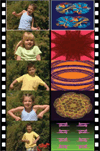Preference for geometric patterns early in life as a risk factor for autism
- PMID: 20819977
- PMCID: PMC4894313
- DOI: 10.1001/archgenpsychiatry.2010.113
Preference for geometric patterns early in life as a risk factor for autism
Abstract
Context: Early identification efforts are essential for the early treatment of the symptoms of autism but can only occur if robust risk factors are found. Children with autism often engage in repetitive behaviors and anecdotally prefer to visually examine geometric repetition, such as the moving blade of a fan or the spinning of a car wheel. The extent to which a preference for looking at geometric repetition is an early risk factor for autism has yet to be examined.
Objectives: To determine if toddlers with an autism spectrum disorder (ASD) aged 14 to 42 months prefer to visually examine dynamic geometric images more than social images and to determine if visual fixation patterns can correctly classify a toddler as having an ASD.
Design: Toddlers were presented with a 1-minute movie depicting moving geometric patterns on 1 side of a video monitor and children in high action, such as dancing or doing yoga, on the other. Using this preferential looking paradigm, total fixation duration and the number of saccades within each movie type were examined using eye tracking technology.
Setting: University of California, San Diego Autism Center of Excellence.
Participants: One hundred ten toddlers participated in final analyses (37 with an ASD, 22 with developmental delay, and 51 typical developing toddlers).
Main outcome measure: Total fixation time within the geometric patterns or social images and the number of saccades were compared between diagnostic groups.
Results: Overall, toddlers with an ASD as young as 14 months spent significantly more time fixating on dynamic geometric images than other diagnostic groups. If a toddler spent more than 69% of his or her time fixating on geometric patterns, then the positive predictive value for accurately classifying that toddler as having an ASD was 100%.
Conclusion: A preference for geometric patterns early in life may be a novel and easily detectable early signature of infants and toddlers at risk for autism.
Figures





References
-
- Lovaas OI. Behavioral treatment and normal educational and intellectual functioning in young autistic children. J Consult Clin Psychol. 1987;55(1):3–9. - PubMed
-
- Cohen H, Amerine-Dickens M, Smith T. Early intensive behavioral treatment: replication of the UCLA model in a community setting. J Dev Behav Pediatr. 2006;27(2 suppl):S145–S155. - PubMed
-
- Hernandez N, Metzger A, Magne´ R, Bonnet-Brilhault F, Roux S, Barthelemy C, Martineau J. Exploration of core features of a human face by healthy and autistic adults analyzed by visual scanning. Neuropsychologia. 2009;47(4):1004–1012. - PubMed
Publication types
MeSH terms
Grants and funding
LinkOut - more resources
Full Text Sources
Other Literature Sources
Medical

